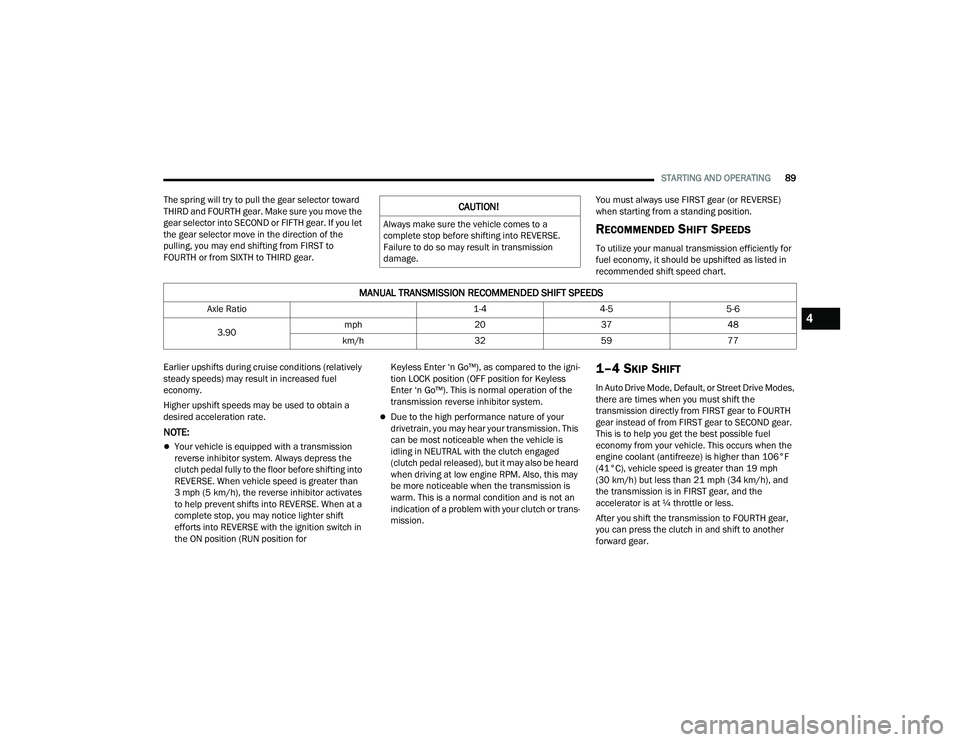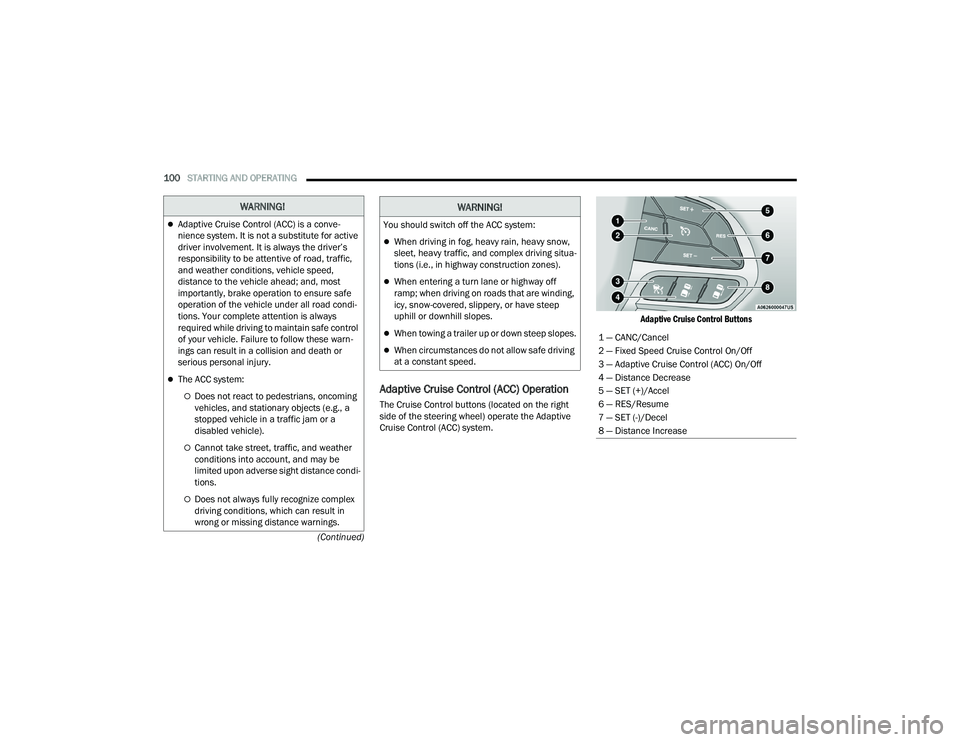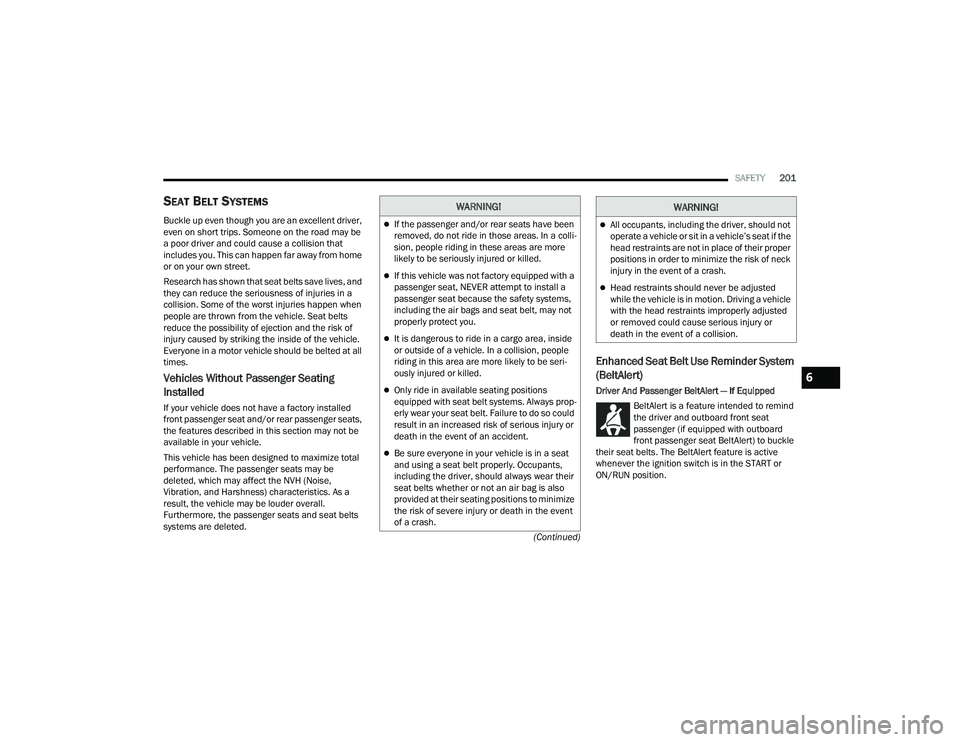street DODGE CHALLENGER 2022 Owners Manual
[x] Cancel search | Manufacturer: DODGE, Model Year: 2022, Model line: CHALLENGER, Model: DODGE CHALLENGER 2022Pages: 336, PDF Size: 16.47 MB
Page 91 of 336

STARTING AND OPERATING89
The spring will try to pull the gear selector toward
THIRD and FOURTH gear. Make sure you move the
gear selector into SECOND or FIFTH gear. If you let
the gear selector move in the direction of the
pulling, you may end shifting from FIRST to
FOURTH or from SIXTH to THIRD gear. You must always use FIRST gear (or REVERSE)
when starting from a standing position.
RECOMMENDED SHIFT SPEEDS
To utilize your manual transmission efficiently for
fuel economy, it should be upshifted as listed in
recommended shift speed chart.
Earlier upshifts during cruise conditions (relatively
steady speeds) may result in increased fuel
economy.
Higher upshift speeds may be used to obtain a
desired acceleration rate.
NOTE:
Your vehicle is equipped with a transmission
reverse inhibitor system. Always depress the
clutch pedal fully to the floor before shifting into
REVERSE. When vehicle speed is greater than
3 mph (5 km/h), the reverse inhibitor activates
to help prevent shifts into REVERSE. When at a
complete stop, you may notice lighter shift
efforts into REVERSE with the ignition switch in
the ON position (RUN position for Keyless Enter ‘n Go™), as compared to the igni
-
tion LOCK position (OFF position for Keyless
Enter ‘n Go™). This is normal operation of the
transmission reverse inhibitor system.
Due to the high performance nature of your
drivetrain, you may hear your transmission. This
can be most noticeable when the vehicle is
idling in NEUTRAL with the clutch engaged
(clutch pedal released), but it may also be heard
when driving at low engine RPM. Also, this may
be more noticeable when the transmission is
warm. This is a normal condition and is not an
indication of a problem with your clutch or trans -
mission.
1–4 SKIP SHIFT
In Auto Drive Mode, Default, or Street Drive Modes,
there are times when you must shift the
transmission directly from FIRST gear to FOURTH
gear instead of from FIRST gear to SECOND gear.
This is to help you get the best possible fuel
economy from your vehicle. This occurs when the
engine coolant (antifreeze) is higher than 106°F
(41°C), vehicle speed is greater than 19 mph
(30 km/h) but less than 21 mph (34 km/h), and
the transmission is in FIRST gear, and the
accelerator is at ¼ throttle or less.
After you shift the transmission to FOURTH gear,
you can press the clutch in and shift to another
forward gear.
CAUTION!
Always make sure the vehicle comes to a
complete stop before shifting into REVERSE.
Failure to do so may result in transmission
damage.
MANUAL TRANSMISSION RECOMMENDED SHIFT SPEEDS
Axle Ratio 1-44-55-6
3.90 mph
203748
km/h 3259774
22_LA_OM_EN_USC_t.book Page 89
Page 102 of 336

100STARTING AND OPERATING
(Continued)
Adaptive Cruise Control (ACC) Operation
The Cruise Control buttons (located on the right
side of the steering wheel) operate the Adaptive
Cruise Control (ACC) system.
Adaptive Cruise Control Buttons
WARNING!
Adaptive Cruise Control (ACC) is a conve
-
nience system. It is not a substitute for active
driver involvement. It is always the driver’s
responsibility to be attentive of road, traffic,
and weather conditions, vehicle speed,
distance to the vehicle ahead; and, most
importantly, brake operation to ensure safe
operation of the vehicle under all road condi -
tions. Your complete attention is always
required while driving to maintain safe control
of your vehicle. Failure to follow these warn -
ings can result in a collision and death or
serious personal injury.
The ACC system:
Does not react to pedestrians, oncoming
vehicles, and stationary objects (e.g., a
stopped vehicle in a traffic jam or a
disabled vehicle).
Cannot take street, traffic, and weather
conditions into account, and may be
limited upon adverse sight distance condi -
tions.
Does not always fully recognize complex
driving conditions, which can result in
wrong or missing distance warnings.
You should switch off the ACC system:
When driving in fog, heavy rain, heavy snow,
sleet, heavy traffic, and complex driving situa -
tions (i.e., in highway construction zones).
When entering a turn lane or highway off
ramp; when driving on roads that are winding,
icy, snow-covered, slippery, or have steep
uphill or downhill slopes.
When towing a trailer up or down steep slopes.
When circumstances do not allow safe driving
at a constant speed.
WARNING!
1 — CANC/Cancel
2 — Fixed Speed Cruise Control On/Off
3 — Adaptive Cruise Control (ACC) On/Off
4 — Distance Decrease
5 — SET (+)/Accel
6 — RES/Resume
7 — SET (-)/Decel
8 — Distance Increase
22_LA_OM_EN_USC_t.book Page 100
Page 203 of 336

SAFETY201
(Continued)
SEAT BELT SYSTEMS
Buckle up even though you are an excellent driver,
even on short trips. Someone on the road may be
a poor driver and could cause a collision that
includes you. This can happen far away from home
or on your own street.
Research has shown that seat belts save lives, and
they can reduce the seriousness of injuries in a
collision. Some of the worst injuries happen when
people are thrown from the vehicle. Seat belts
reduce the possibility of ejection and the risk of
injury caused by striking the inside of the vehicle.
Everyone in a motor vehicle should be belted at all
times.
Vehicles Without Passenger Seating
Installed
If your vehicle does not have a factory installed
front passenger seat and/or rear passenger seats,
the features described in this section may not be
available in your vehicle.
This vehicle has been designed to maximize total
performance. The passenger seats may be
deleted, which may affect the NVH (Noise,
Vibration, and Harshness) characteristics. As a
result, the vehicle may be louder overall.
Furthermore, the passenger seats and seat belts
systems are deleted.
Enhanced Seat Belt Use Reminder System
(BeltAlert)
Driver And Passenger BeltAlert — If Equipped BeltAlert is a feature intended to remind
the driver and outboard front seat
passenger (if equipped with outboard
front passenger seat BeltAlert) to buckle
their seat belts. The BeltAlert feature is active
whenever the ignition switch is in the START or
ON/RUN position.
WARNING!
If the passenger and/or rear seats have been
removed, do not ride in those areas. In a colli -
sion, people riding in these areas are more
likely to be seriously injured or killed.
If this vehicle was not factory equipped with a
passenger seat, NEVER attempt to install a
passenger seat because the safety systems,
including the air bags and seat belt, may not
properly protect you.
It is dangerous to ride in a cargo area, inside
or outside of a vehicle. In a collision, people
riding in this area are more likely to be seri -
ously injured or killed.
Only ride in available seating positions
equipped with seat belt systems. Always prop -
erly wear your seat belt. Failure to do so could
result in an increased risk of serious injury or
death in the event of an accident.
Be sure everyone in your vehicle is in a seat
and using a seat belt properly. Occupants,
including the driver, should always wear their
seat belts whether or not an air bag is also
provided at their seating positions to minimize
the risk of severe injury or death in the event
of a crash.
All occupants, including the driver, should not
operate a vehicle or sit in a vehicle’s seat if the
head restraints are not in place of their proper
positions in order to minimize the risk of neck
injury in the event of a crash.
Head restraints should never be adjusted
while the vehicle is in motion. Driving a vehicle
with the head restraints improperly adjusted
or removed could cause serious injury or
death in the event of a collision.
WARNING!
6
22_LA_OM_EN_USC_t.book Page 201